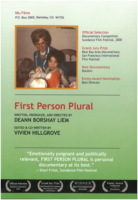Last Updated on January 17, 2022 by themigrationnews
Documentary. In English. Running time: 1 hour.
In the heartbreaking documentary First Person Plural, DeannBorshayDeann, a Korean adoptee traces her emotional journey from Sun Duk orphanage in South Korea as Cha Jung Hee to growing up in the US as Deann Borshay and finally rediscovering her real identity as Kang Ok jin and her “real family” in South Korea. Beyond the story of reconciliation and rediscovery, the documentary provides the viewers a glimpse into transnational adoption, denoted as the “Quiet Migration” by demographers, from the perspective of the adoptee.
Transnational adoption has been treated as a form of unusual migration and focus on its adoptee immigrants have largely been absent from migration studies. Particularly there is a dearth of studies on the implications of such immigration. In the light of this, a documentary such as First Person Plural that explores the personal experience of the adoptee in navigating notions of identity and belongingness is of great significance.

Push and Pull Factors
However, the documentary is not confined to a depiction of the aftermath, rather it allows a peek at the push and pull factors that set this migration in motion. Historically placing Deann’s adoption in the 1960s, and taking into consideration her mother’s narration of the events leading to her adoption, it is clear that the adoption was motivated by humanitarian gestures. We can also see the role media played in influencing the pull factor when Deann’s mother discloses that it was the Gary Moore show encouraging people to contribute towards the cause of the needy children in the east that prompted her. In the current anti-immigrant, anti-refugee climate, it is ironic that children of the “underdeveloped” world and their needs are sacralized in the discourse of transnational adoption, but at the same time refugees adults and minors, fleeing the very same poverty-stricken countries are rejected.
Similar to other forms of migration that are hard to compartmentalize into clear-cut boxes of voluntary and involuntary, the migration caused by transnational adoption also appears to be located somewhere on a continuum of voluntary and forced migration. First Person Plural outlines this aspect very clearly. It also portrays how migration cannot be analyzed solely from the individual level and must be considered in the larger context. The documentary presents the push factors that led to Deann’s adoption against the larger picture of South Korea’s adoption “industry” and commercialization of children that were present at the time. It was extreme poverty coupled with the influence of the adoption industry that forced Deann’s birth mother to give up her child.
Finding Her Place
The first half of the documentary follows Deann’s arrival in the US and her attempts at integration into the family and the American society in general, which in many ways resonates with the attempts of other immigrants as well. Deann narrates her initial efforts at holding on to the memories of her home back in Korea and her real identity, but these memories are soon lost in her struggle to fit in. The viewers also get to comprehend how a racially different little girl in a predominantly white suburb grapples with the racialized disconnect between her body and her surroundings. Growing up Deann struggles with her looks, she is upset about not being able to make her eyes look like her sisters, she even goes on to get plastic surgery for her ears to stop them from sticking out. In the documentary, Deanne states that she looked upto her brother and sister to understand what was “American” and tried to emulate that. “I think I somehow had created this sort of collage of things and made myself over to fit all the little things that I had seen”. The importance of representation and providing transnational adoptee children exposure to their roots is made apparent through these scenes and narrations. Would little Deannhave had to struggle with her appearance and the “American” way, if she had encountered people similar to her?
Rediscovery and Reconciliation
The American spell is finally broken and Deann embarks on a journey of self-rediscovery when she moves out from her home and hometown. But the documentary does not divulge the reason as to why she suddenly starts to regain the suppressed memories from her childhood. Here we are left to speculate whether it was the interaction with the outside world without the protection of her white adoptive family that situated her existence in a racially different world that led her on a search for her roots. Although transnational adoptees are not regarded as immigrants and are accorded greater respect, the similarity of appearance connects them with immigrants and this leads to them being excluded and discriminated against as other immigrants are. This confrontation with racism can come as a shocking contradiction to these adoptees’ years-long attempt at emulating the identity of those around them and the sense of self they had created.
The second half shows Deann again struggling with her identity but this time it’s a different sort of struggle. While before she had been trying hard to fit into the American society, suddenly here she finds herself with two different identities. Exploring her real roots, Deann comes to know that she was not an orphan and her real name is Kang Ok Jin. She grapples with not knowing where she truly belongs. With cultural and linguistic connections with her native society lost, Deann is unable to even communicate with her birth mother. Nonetheless, in Korea, Deann feels a sense of familiarity and affinity with the people, the place, and things while simultaneously in some ways she still was a stranger, just a visitor. In order to establish a connection with both identities simultaneously, Deann decides to bring both her worlds together to one place. When the two families meet in Korea, we see the complexities and confusions this adoption has created but concurrently we witness a surreal reunion filled with tears, joy, and gratitude. Perhaps it is here that the viewer is still after all that happened can appreciate transnational adoption. Even though her family in Korea is deeply saddened about the time and connection they lost with Deann, they are thankful that she had a loving family and was able to get a lot of opportunities, including education which she would not have got if she had stayed back.
Through First Person Plural, Deann BorshayDeannwas successful in capturing the first-hand experience of a transnational adoptee. It highlighted the complexities and hardships that an adoptee experience even with well-meaning, and loving adoptive family. The core themes of the documentary are identity and belongingness and the bond between families. Yet it has also managed to record the various aspects of the quiet migration. Considering the moral panic that conservatives across the world are creating about immigration, First Person Plural uncovers the significance of listening to the experience of the transnational adoptee immigrants. The unique position of privilege that these transnational adoptees occupy when compared to other migrants was clearly visible in the documentary, however, this comes at the price of not fully belonging to either identity and finding themselves in a minority who are placed somewhere in-between.

Anusree P is a sociology postgraduate from Pondicherry University. Her areas of interest include internal displacement, forced migration, refugees and their governance. Twitter: https://twitter.com/anusreepp2
